Originally published on Sep 3, 2023
The media are using Hurricane Idalia to spread the false narrative that fossil fuels make extreme weather danger worse.
In reality, fossil fuels make us safer from extreme weather.
Here are answers to the media's top 25 extreme weather myths.1
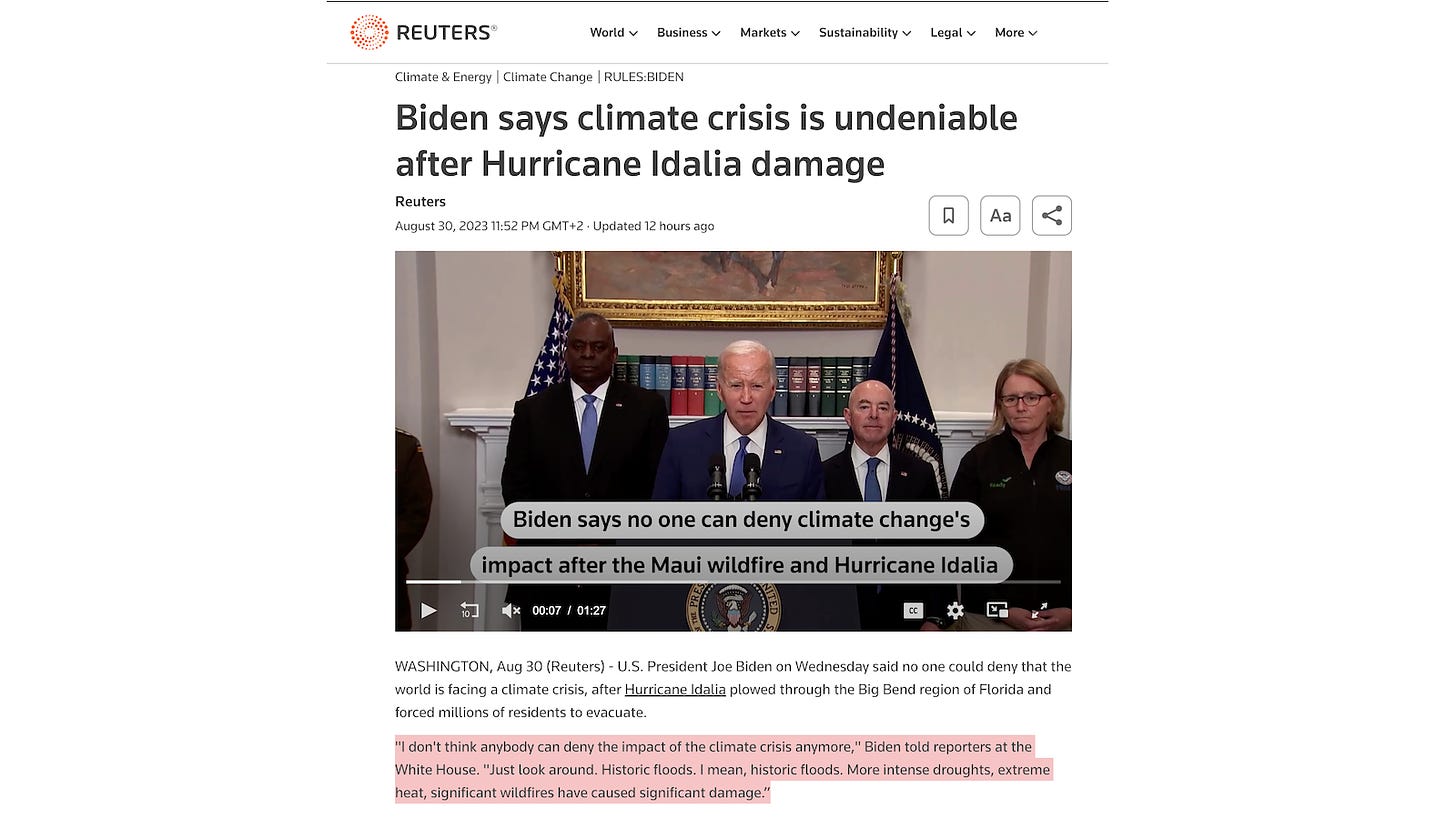
-
Myth 1: The world is experiencing unprecedented danger from extreme weather thanks to fossil fuels.
Truth: The world is experiencing unprecedented safety from extreme weather thanks to FFs—because FFs' climate mastery benefits overwhelm any negative climate side-effects.2
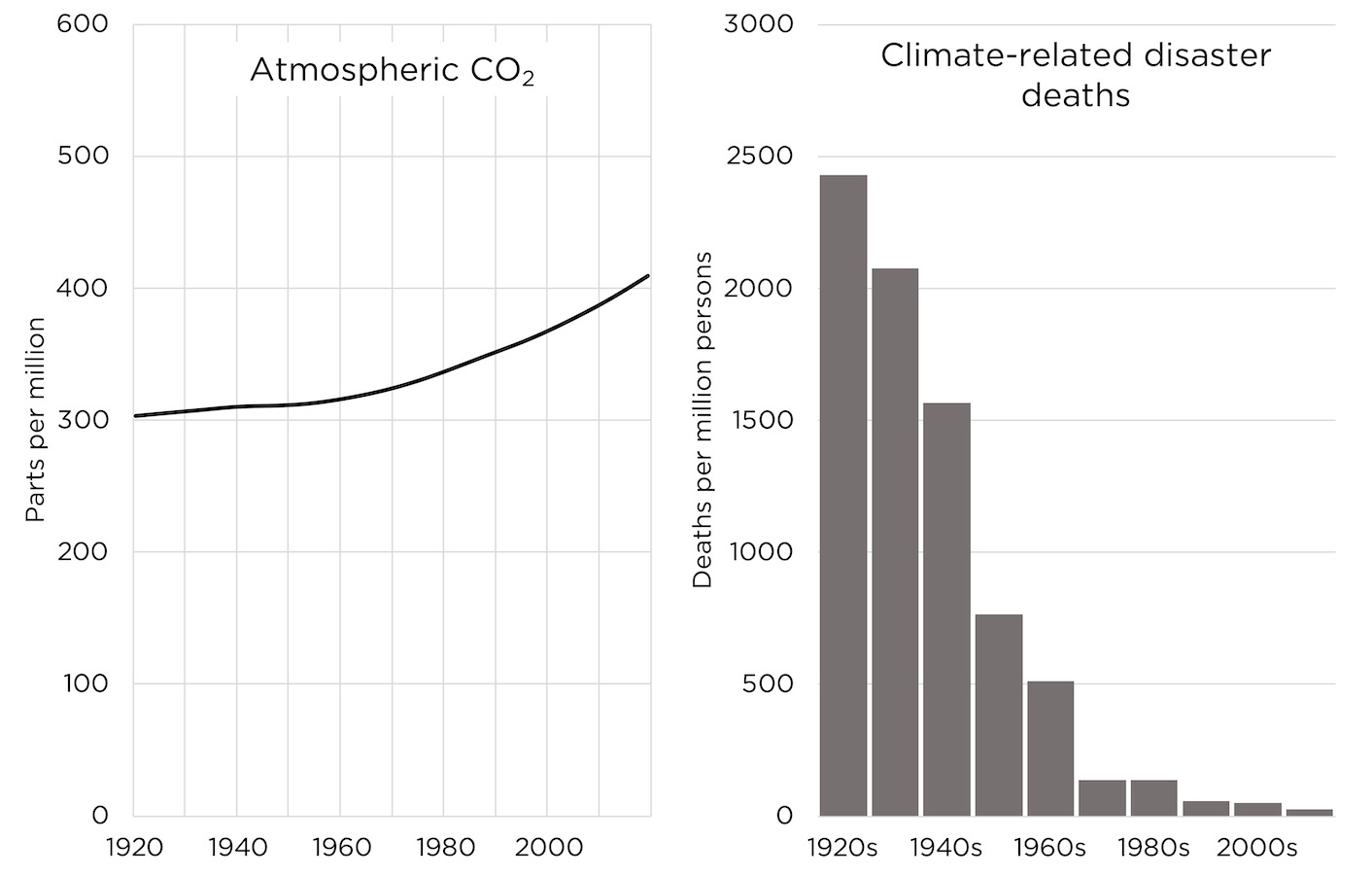
-
Myth 2: The media and its designated experts are accurately reporting on fossil fuels and extreme weather.
Truth: The media and its “experts” are:
1. totally ignoring how fossil fuels make us safer than ever from extreme weather
2. wildly overstating fossil fuels' negative impact on weather. -
Myth 3: The effect of fossil fuels on extreme weather danger is solely negative.
Truth: Not only can warming from fossil fuels have significant benefits (fewer cold deaths) but the low-cost energy fossil fuels provide for billions gives us an unprecedented ability to master extreme weather.
-
Fossil fuels have made us far safer from extreme weather by providing low-cost energy for the amazing machines that protect us against storms, protect us against extreme temperatures, and alleviate drought. Deaths from extreme weather have decreased 98% over the last century!3
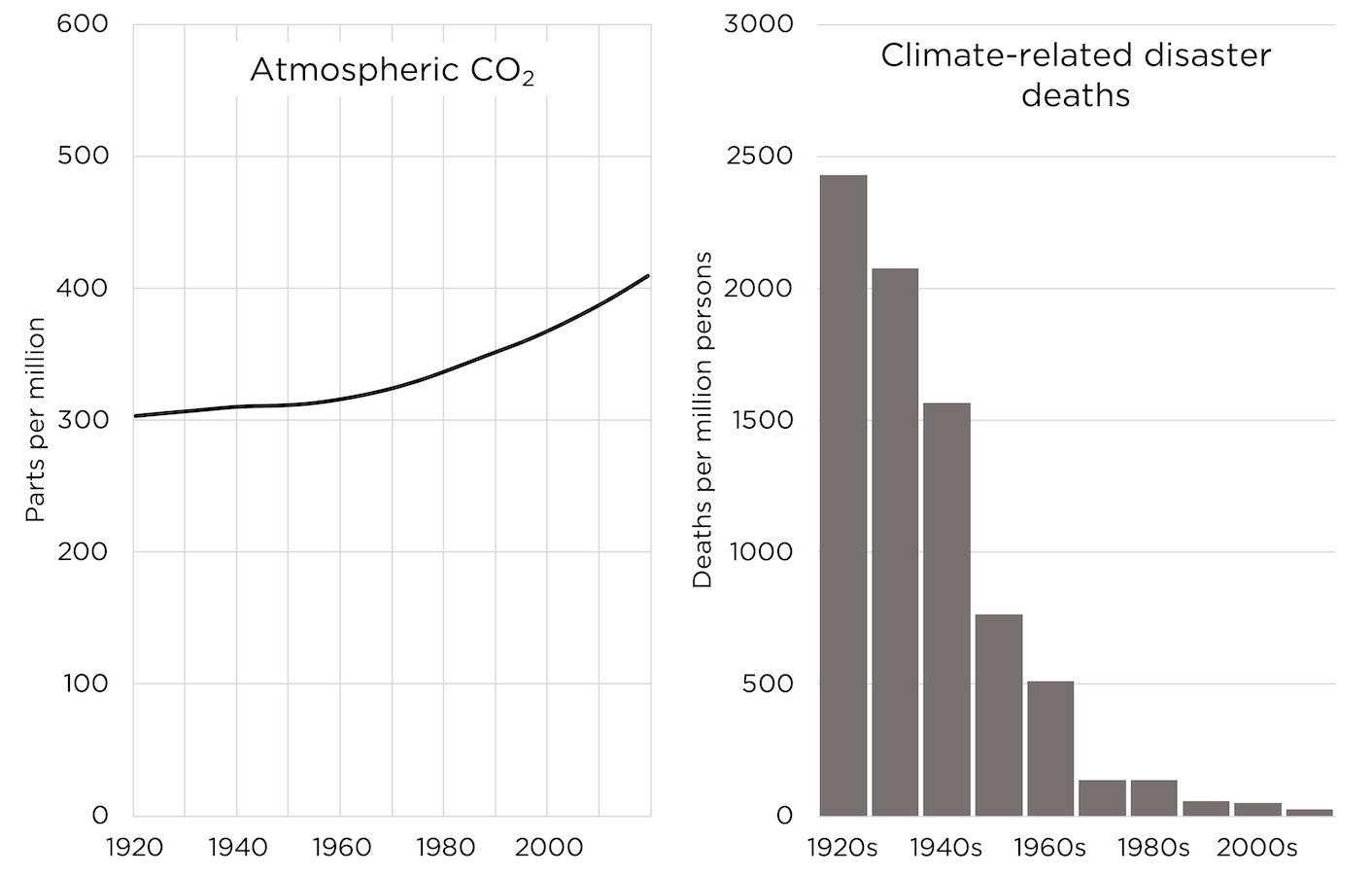
-
Myth 4: We don't need fossil fuels to protect ourselves from extreme weather—we can just use alternatives.
Truth: As Europe is illustrating, there is no near-term replacement for fossil fuels for the 1/4 of the world that uses abundant energy—let alone the 3/4 of the world that doesn't.4
-
Fossil fuels will for decades remain uniquely able to provide low-cost, reliable energy to billions. That's why fossil fuels are 80% of world energy and still growing.
Restricting fossil fuel use means far less energy for climate mastery activities such as heating, cooling, and irrigation.5
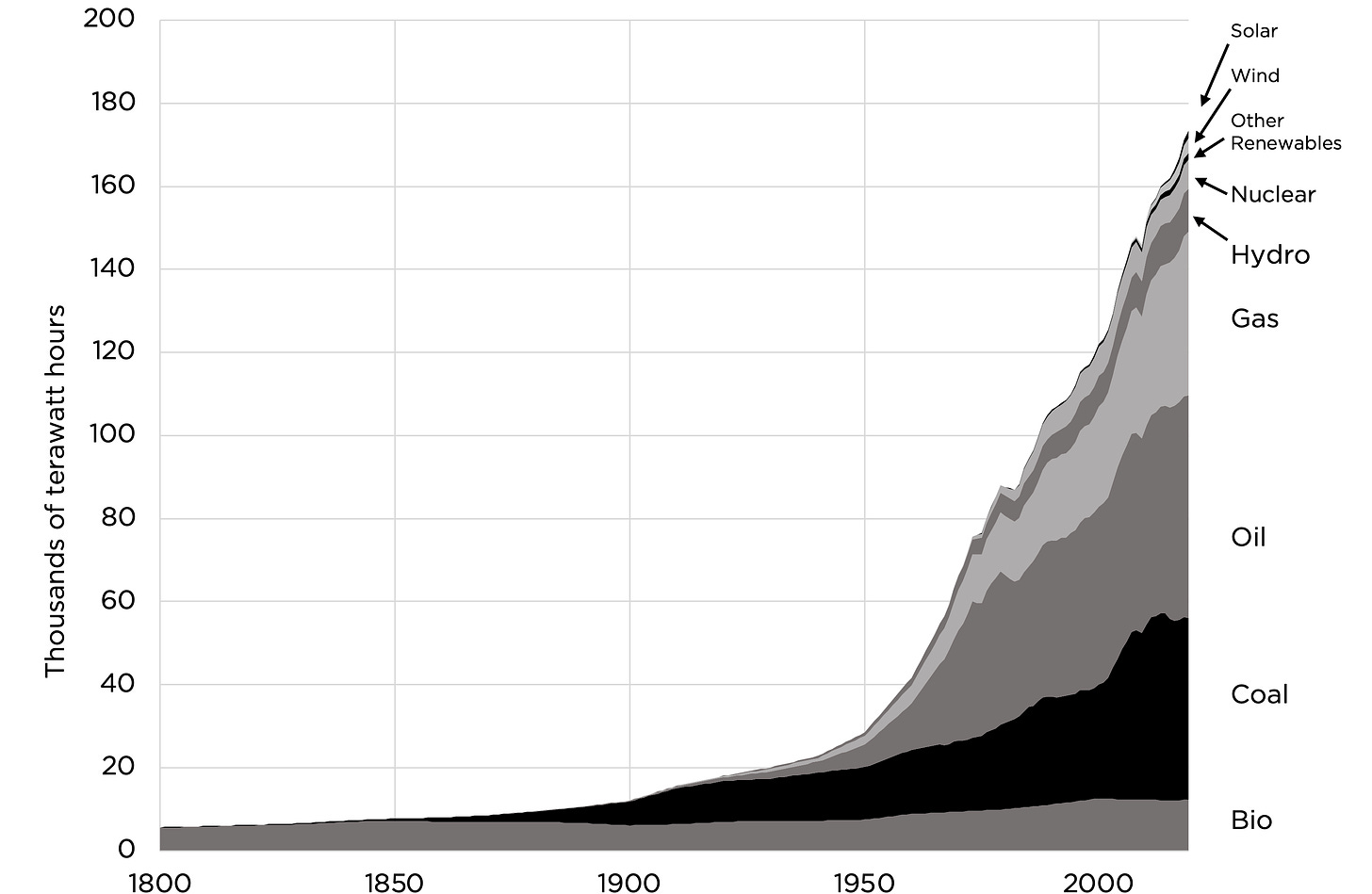
-
Myth 5: The media and its designated experts are accurately reporting the scientific linking of fossil fuel use and hurricanes.
Truth: This “reporting” is riddled with
1. deliberate misrepresentations (e.g., hurricane frequency)
2. biases (e.g., only reporting negative links) -
Myth 6: Media claims about increasing hurricane frequency are accurate.
Truth: Leading media outlets have deliberately misrepresented the flat long-term hurricane trend. E.g., the New York Times cherry-picking a starting point—the low point of 1980—to make a flat trend seem upward.6
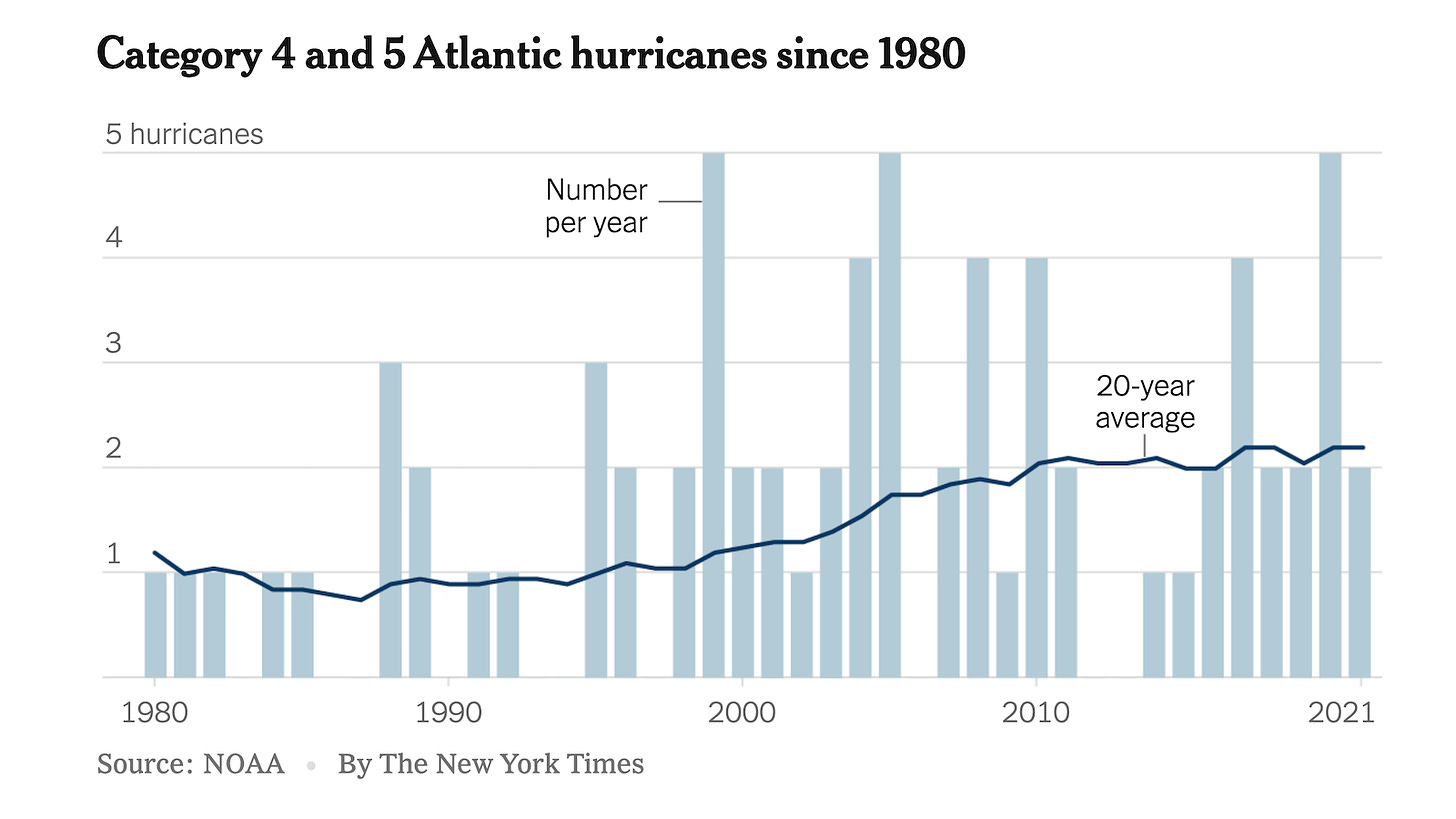
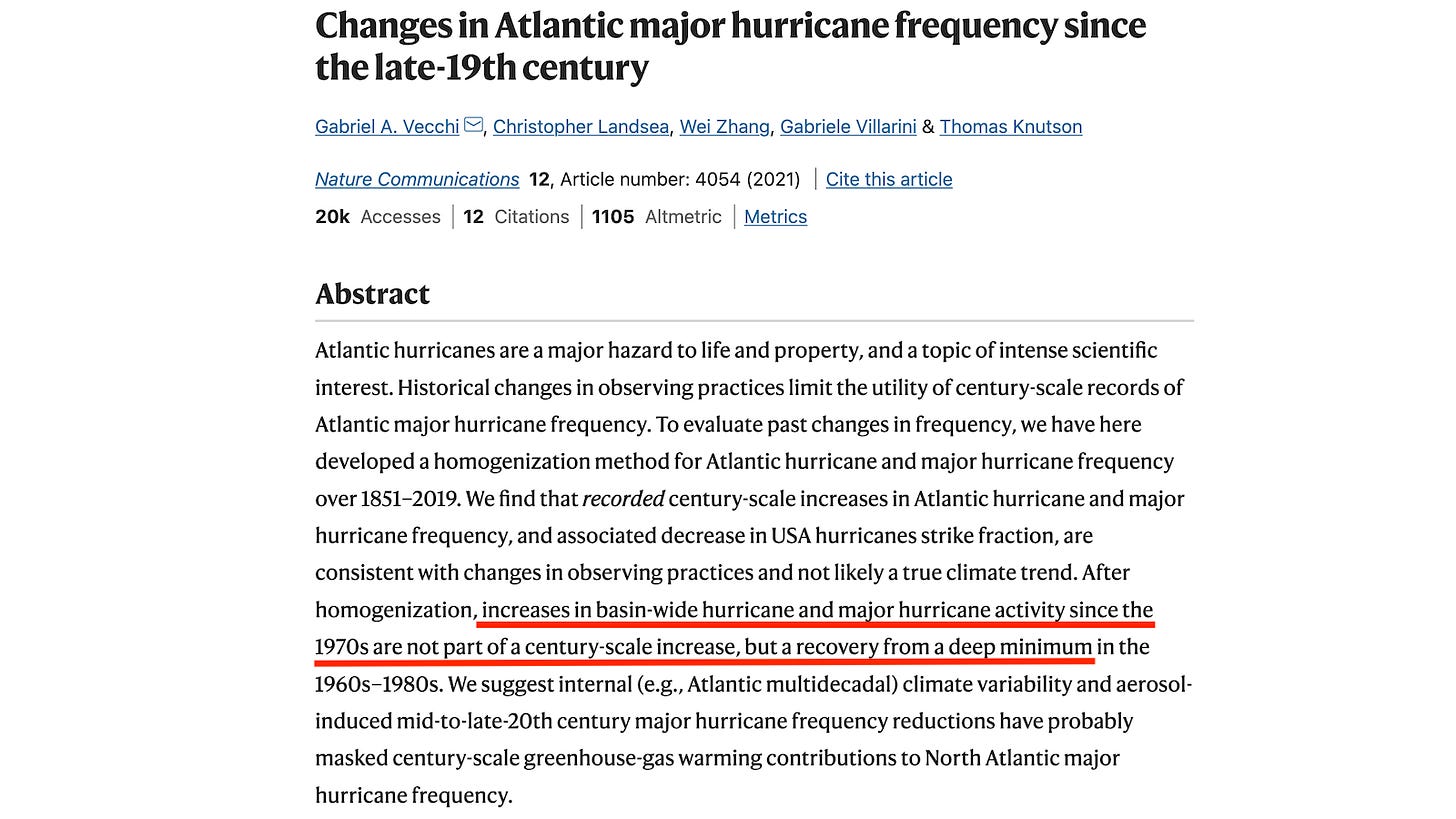
-
Leading media outlets have also deliberately ignored statements by the National Oceanographic and Atmospheric Administration and the Intergovernmental Panel on Climate Change about how any increases in hurricane frequency in records are likely due to increasing reporting, not actual frequency.7
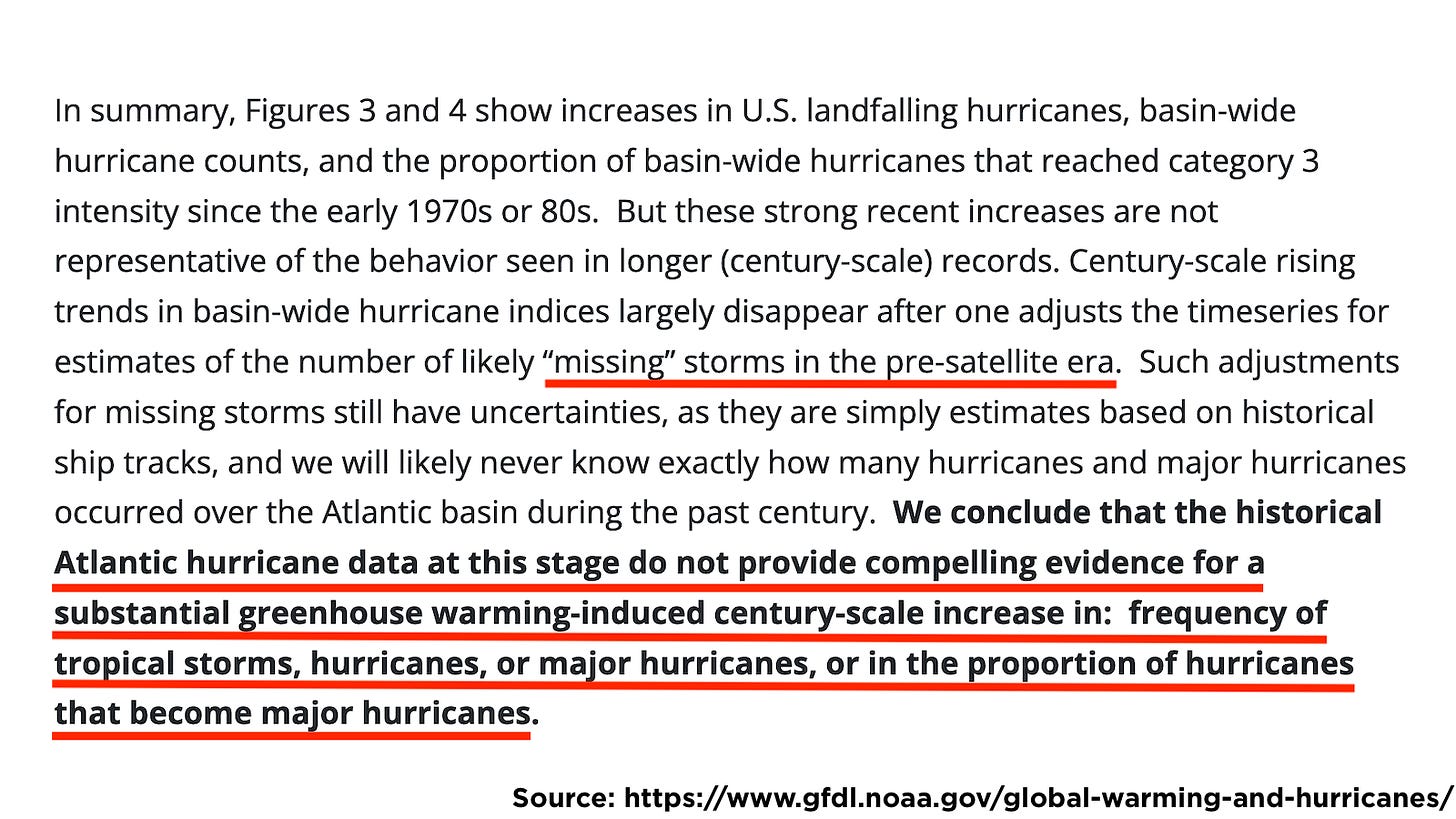
-
Here are the latest data on global hurricane frequency and intensity from a 2022 paper (Klotzbach et al). Does this remotely resemble what trusted media sources tell you?8
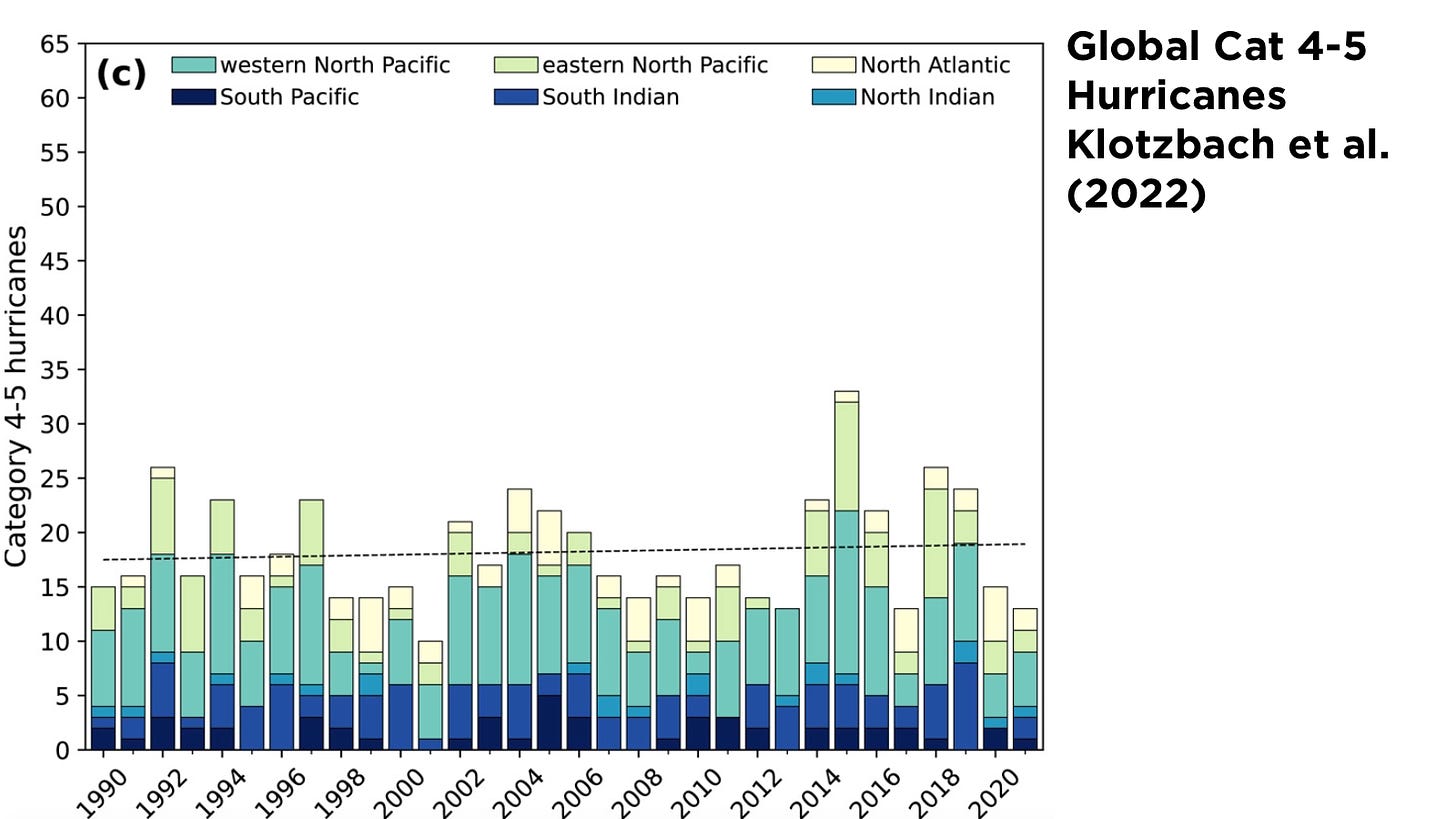
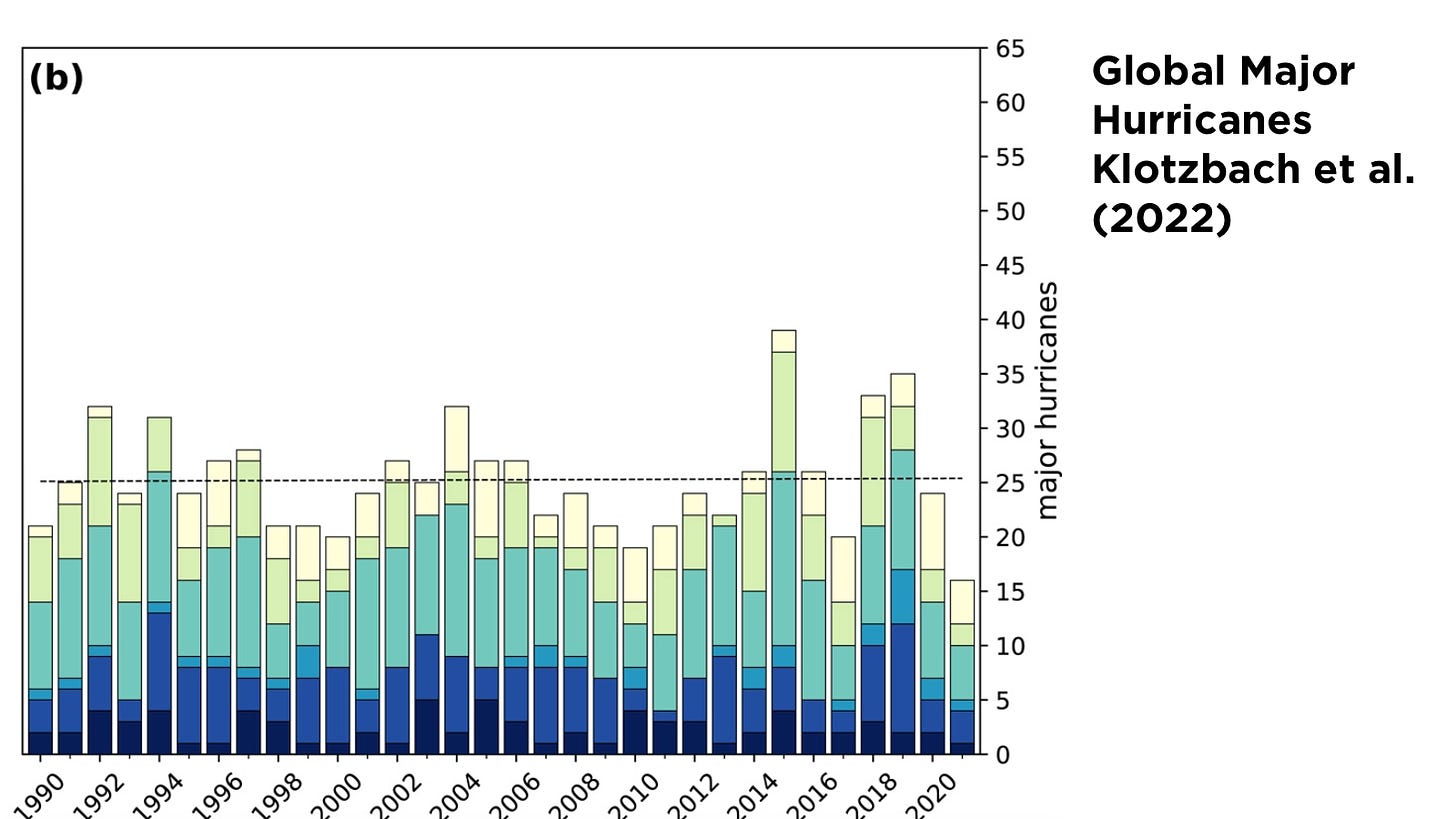
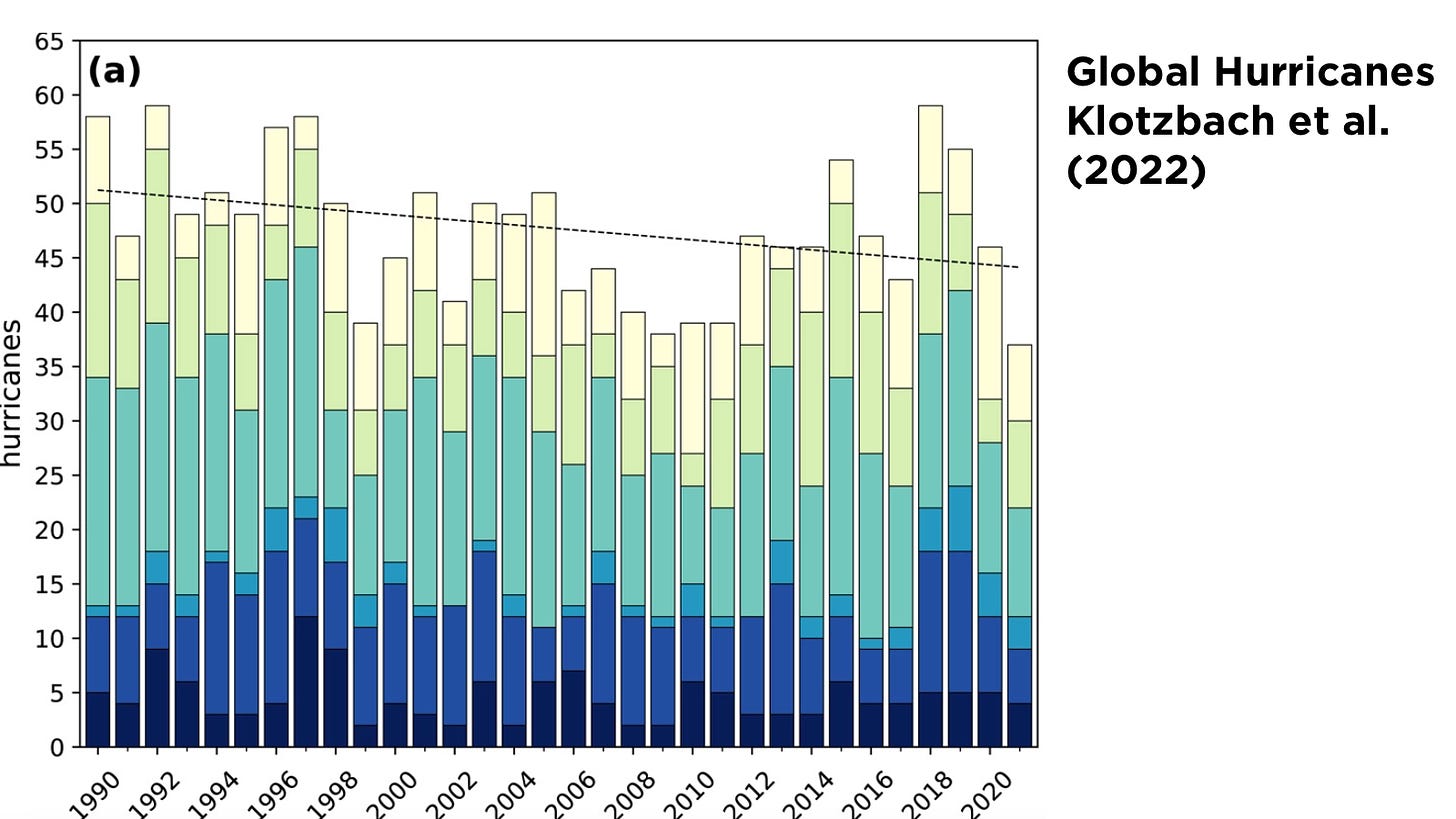
-
Here's recent US data for landfalling hurricanes, both overall and major. Again, consuming the New York Times and other trusted sources would you have any idea that the data looked like this?9
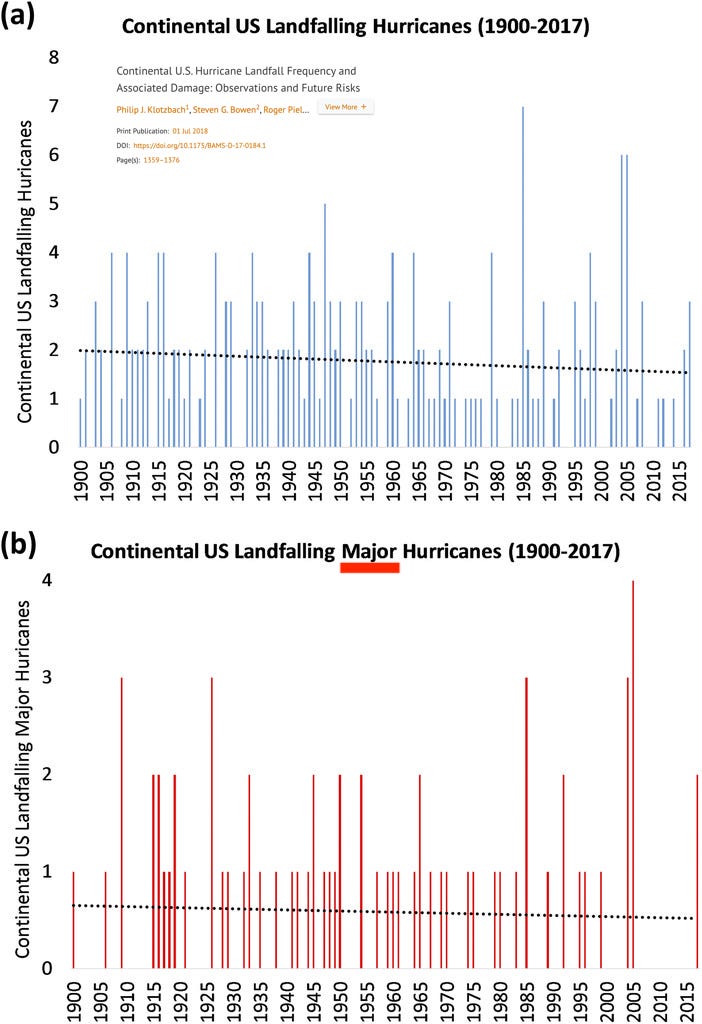
-
Myth 7: Hurricanes are expected to get more frequent as temperatures rise.
Truth: Mainstream science expects that hurricanes will become less frequent as temperatures rise.10
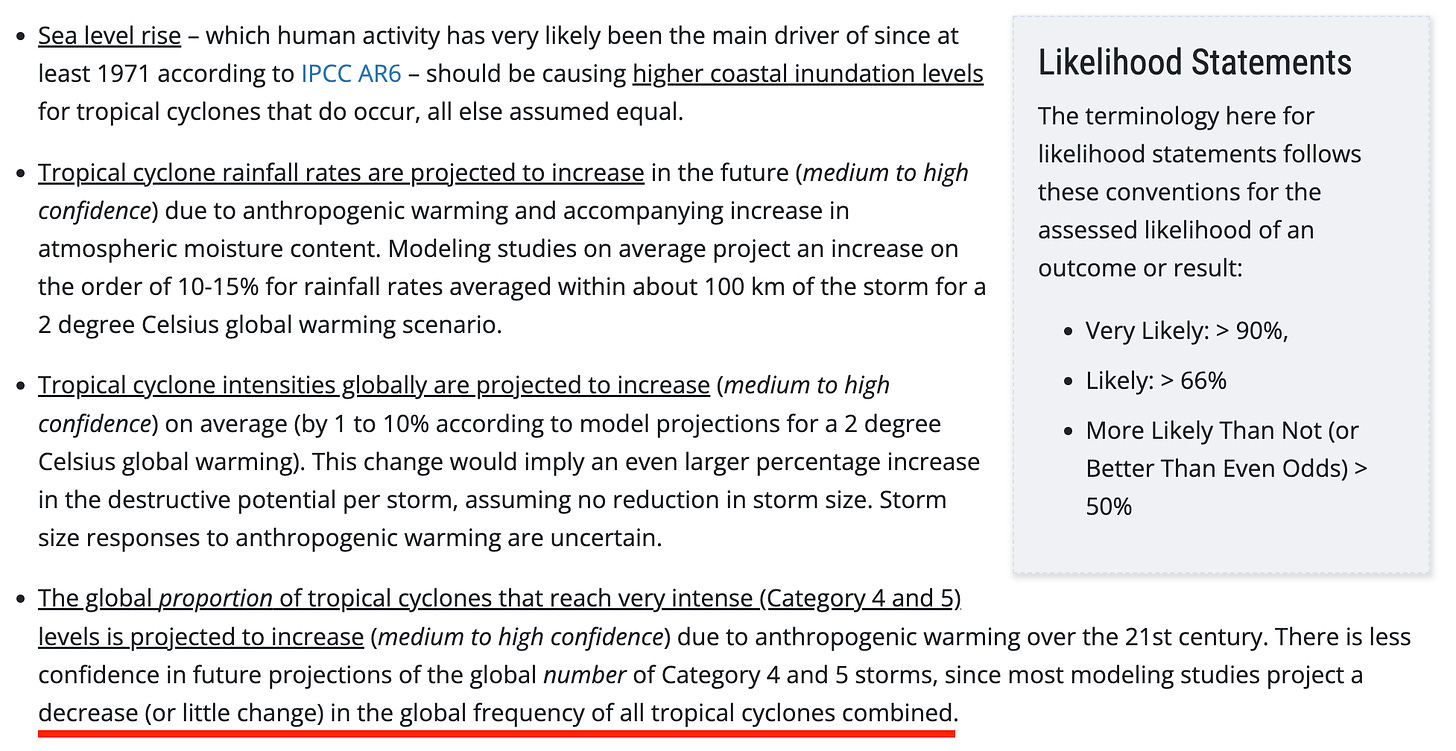
-
Myth 8: Hurricane intensity is expected to get catastrophically higher as temperatures rise.
Truth: Mainstream estimates say hurricanes will be less frequent and between 1-10% more intense. This is not at all catastrophic if we continue our fossil-fueled climate mastery.11

-
Myth 9: Media-cited research on extreme weather is unbiased.
Truth: Extreme weather research is riddled with biases. In addition to ignoring fossil-fueled climate mastery, many researchers have overtly political motives and ignore positive impacts of fossil fuels on weather.
-
Myth 10: Climate researchers have no political bias.
Truth: Certain climate attribution “scientists” admit that they are motivated by political goals and shape their “science” accordingly. E.g., media favorite Friederike Otto wants climate research “on the offensive.”12
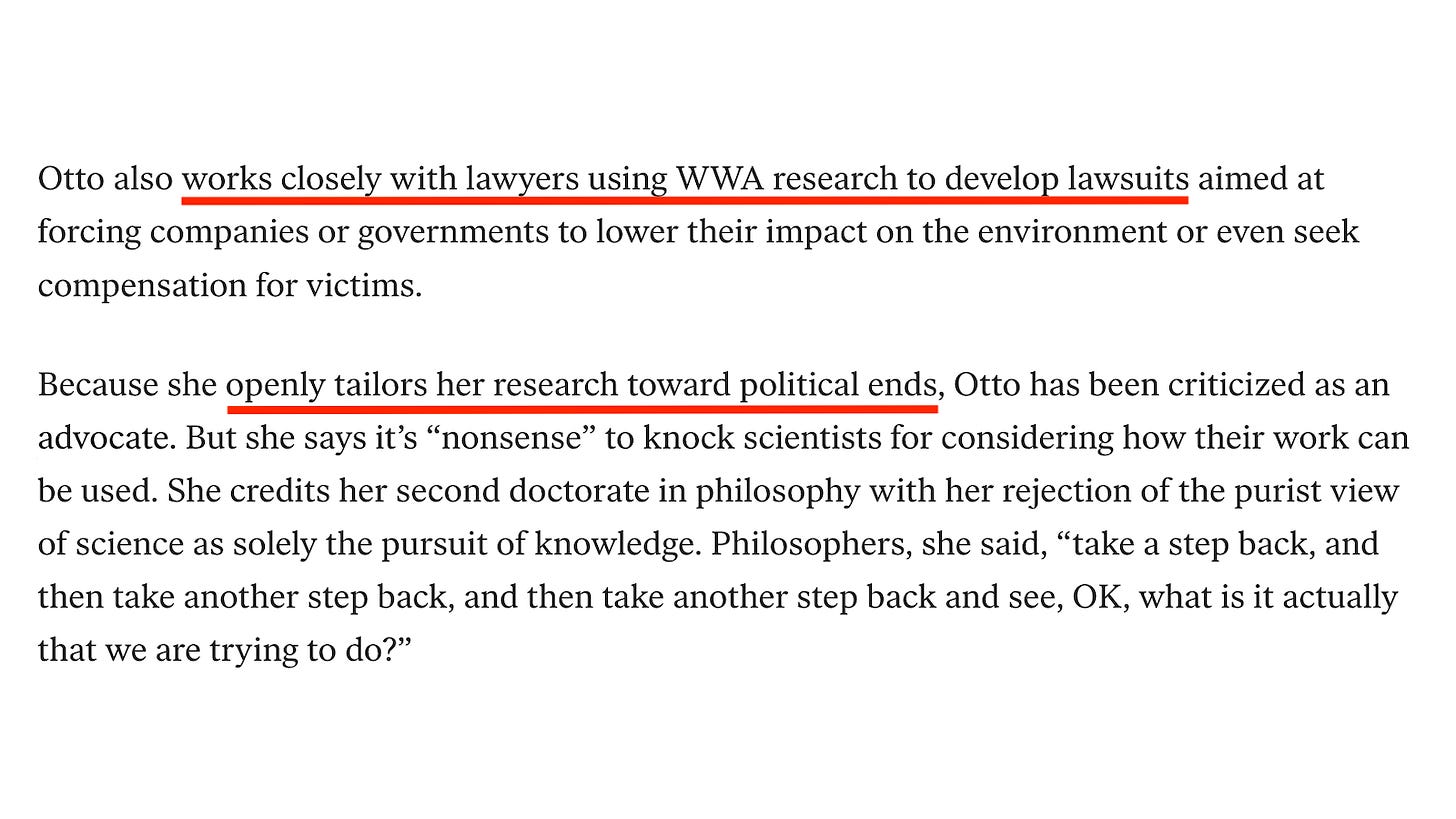
-
Myth 11: Extreme weather “attribution” researchers are simply trying to understand extreme weather and have found fossil fuels guilty.
Truth: Extreme weather “attribution” only looks for negative impacts of fossil fuels on extreme weather, brazenly ignoring any avoided negative impacts.
-
One of the few climate researchers who is openly looking at the full impact of fossil-fueled climate change, including potential avoided damage, is meteorologist and hurricane expert Dr. Ryan Maue. What are the chances we see his point about avoided hurricanes in the mainstream news?
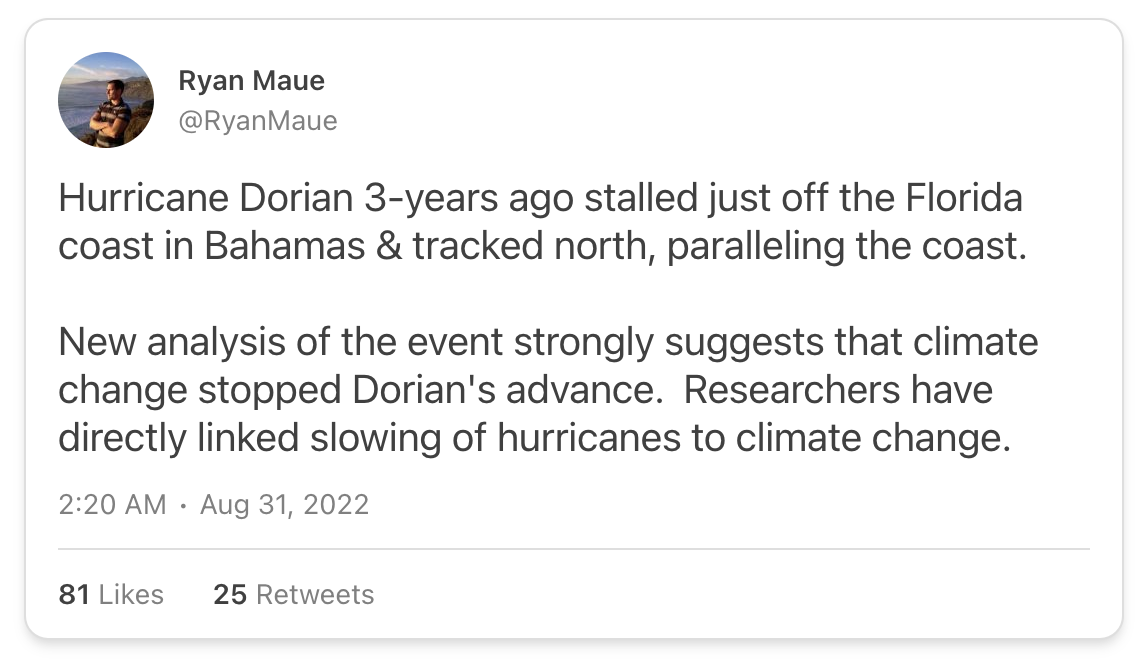
-
Myth 12: Attributions of X% of an extreme weather event to humans are credible.
Truth: Not only are many attributors clearly biased, but no precise estimate of this kind is possible given today’s climate modeling limits, where mainstream models hugely diverge from one another.13
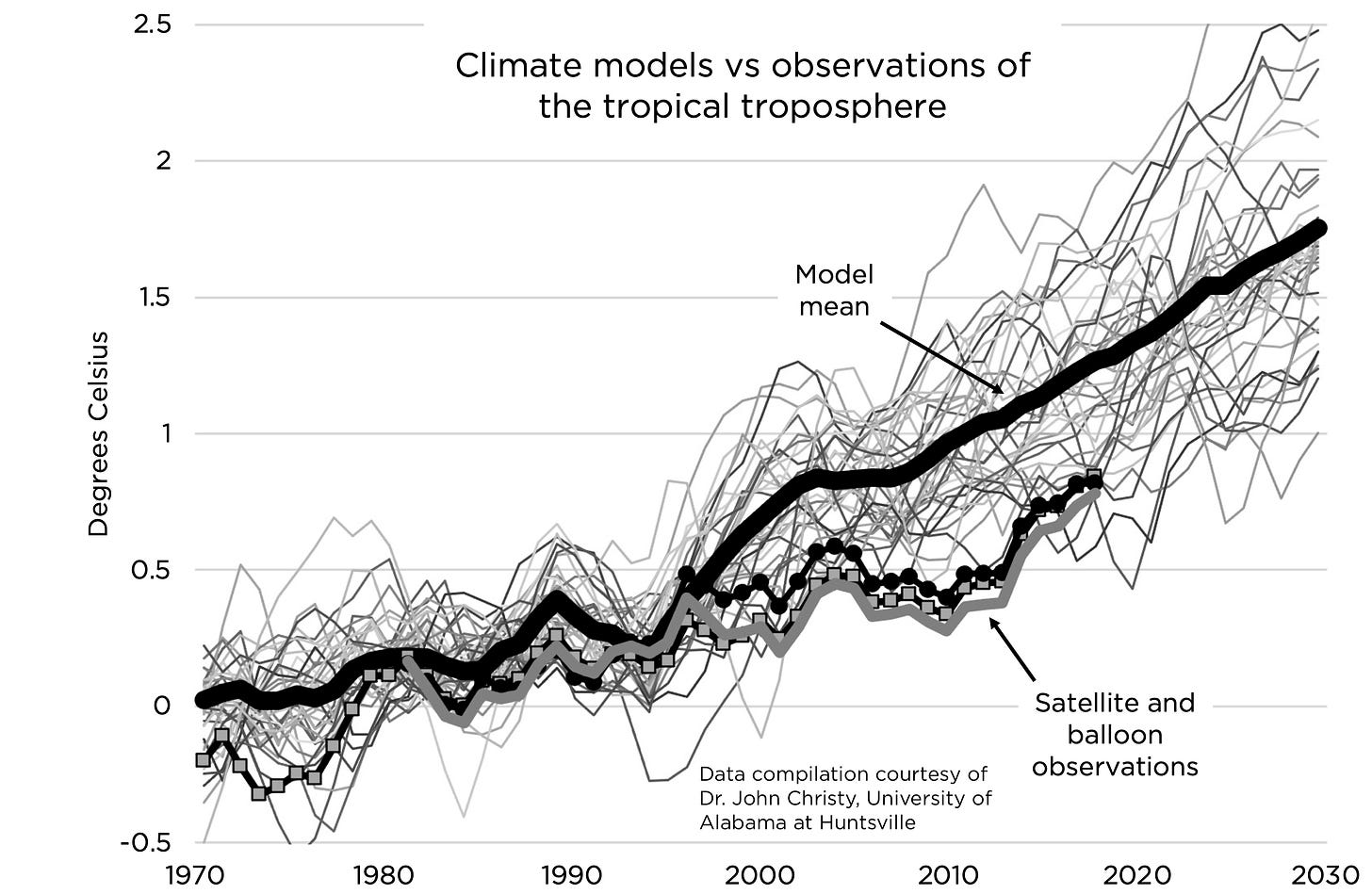
-
Myth 13: Fossil fuels made Hurricane Idalia worse for Florida.
Truth: While we can’t know exactly how Idalia was different because of human climate impacts, we know that without fossil fuels Florida would be a third-world place that Idalia would have utterly devastated.
-
We also don't know how many hurricanes the US East Coast and other vulnerable spots dodged or will avoid thanks to global warming. Models cannot give us this information and since it's not a negative, no mainstream and public researcher in the field is looking for ways to find out.
-
Myth 14: Thanks to fossil fuels more people are dying from extreme weather.
Truth: Thanks to fossil fuels more people are not dying from extreme weather—and everything else. Fossil-fueled prosperity has driven climate disaster deaths down 98% and life expectancy up by decades.14
-
Myth 15: Thanks to fossil fuels we are suffering overwhelming damage from extreme weather.
Truth: The trend of real weather damage is flat—despite many factors increasing vulnerability, like increasing coastal populations and bad incentives from government bailout policies.15
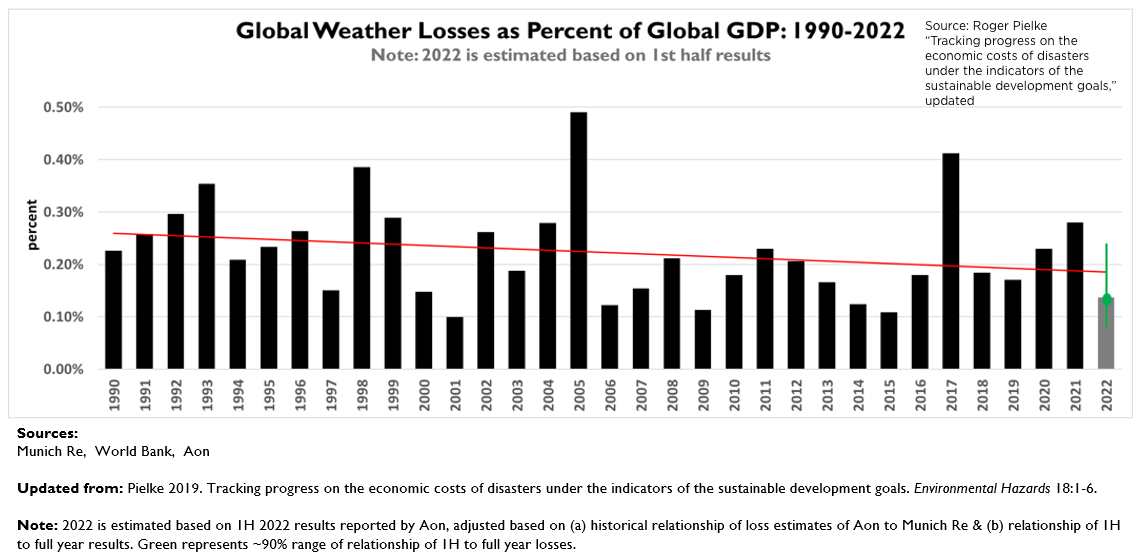
-
3 keys to understanding climate damage statistics:
1. Damage should be measured percentage of GDP not compared dollar-for-dollar to a poorer past with less wealth at risk. (E.g., Miami Beach)
2. More people today choose to live in damage-prone areas.
3. Government bailout policies increase damage.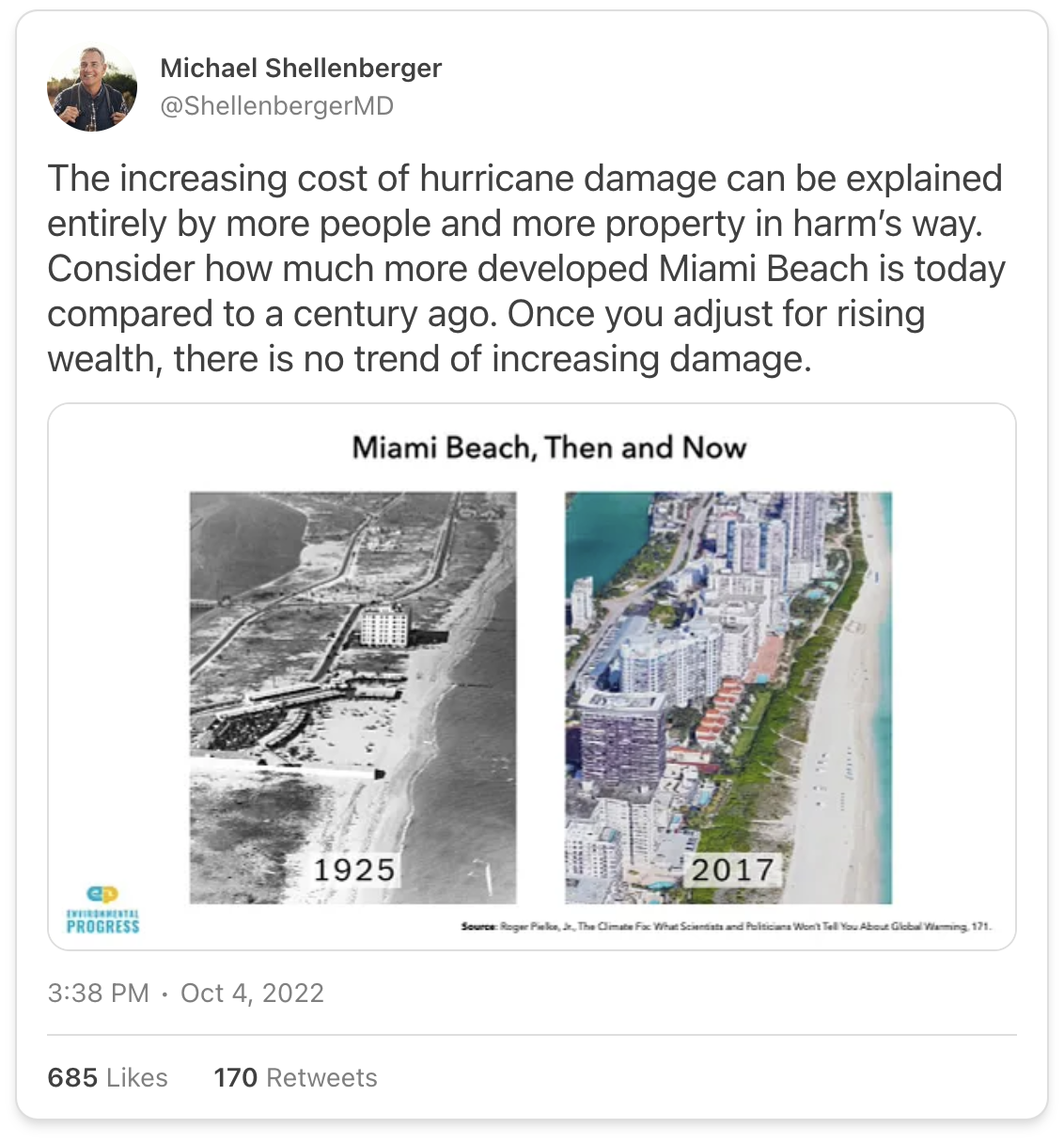
-
Myth 16: Extreme temperatures are a bigger danger than ever thanks to fossil fuels.
Truth: Extreme temperatures are a smaller danger than ever thanks to fossil-fueled heating and A/C—plus the net-benefits of warming in a world where far more people die of cold than heat.16
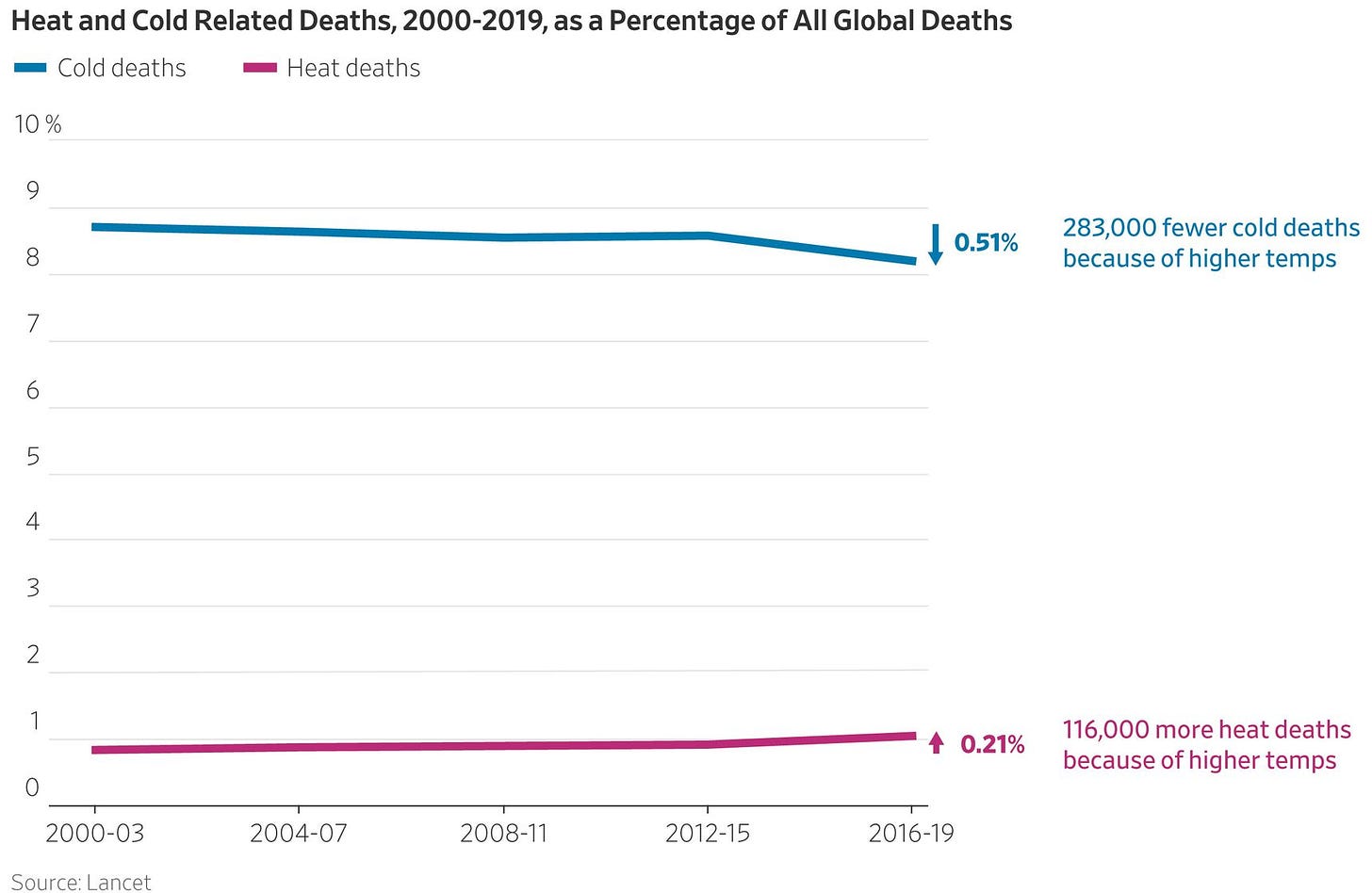
-
Myth 17: Storms are a bigger danger than ever thanks to fossil fuels.
Truth: Storms are a smaller danger than ever thanks to the fossil-fueled machines that build sturdy buildings, as well as fossil-fueled weather warning systems and fossil-fueled disaster relief efforts.17
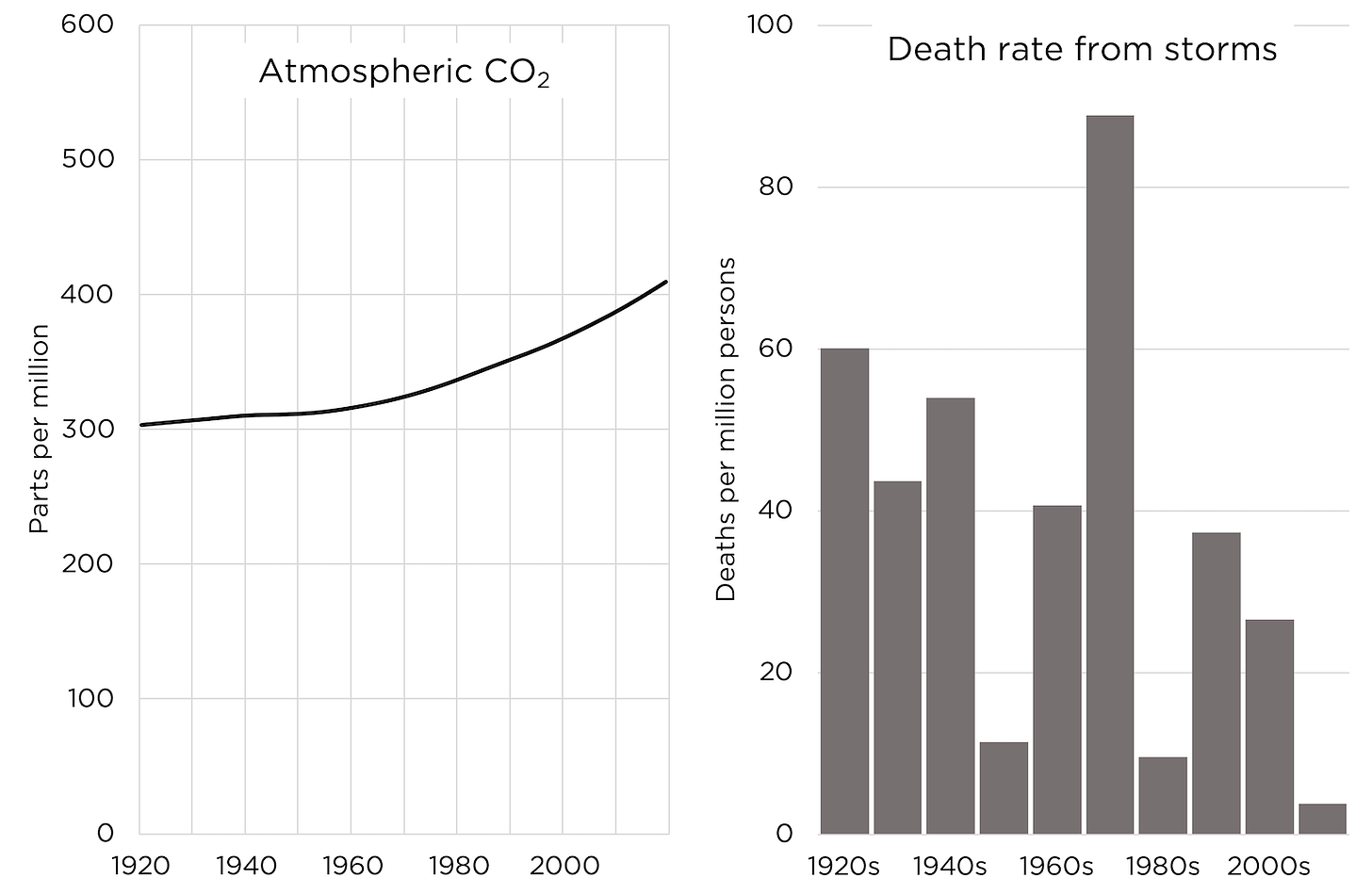
-
Myth 18: Drought is a bigger danger than ever thanks to fossil fuels.
Truth: Drought is a smaller danger than ever thanks to fossil-fueled irrigation, crop transport, and agriculture. With more such mastery our crop productivity can continue to improve.18
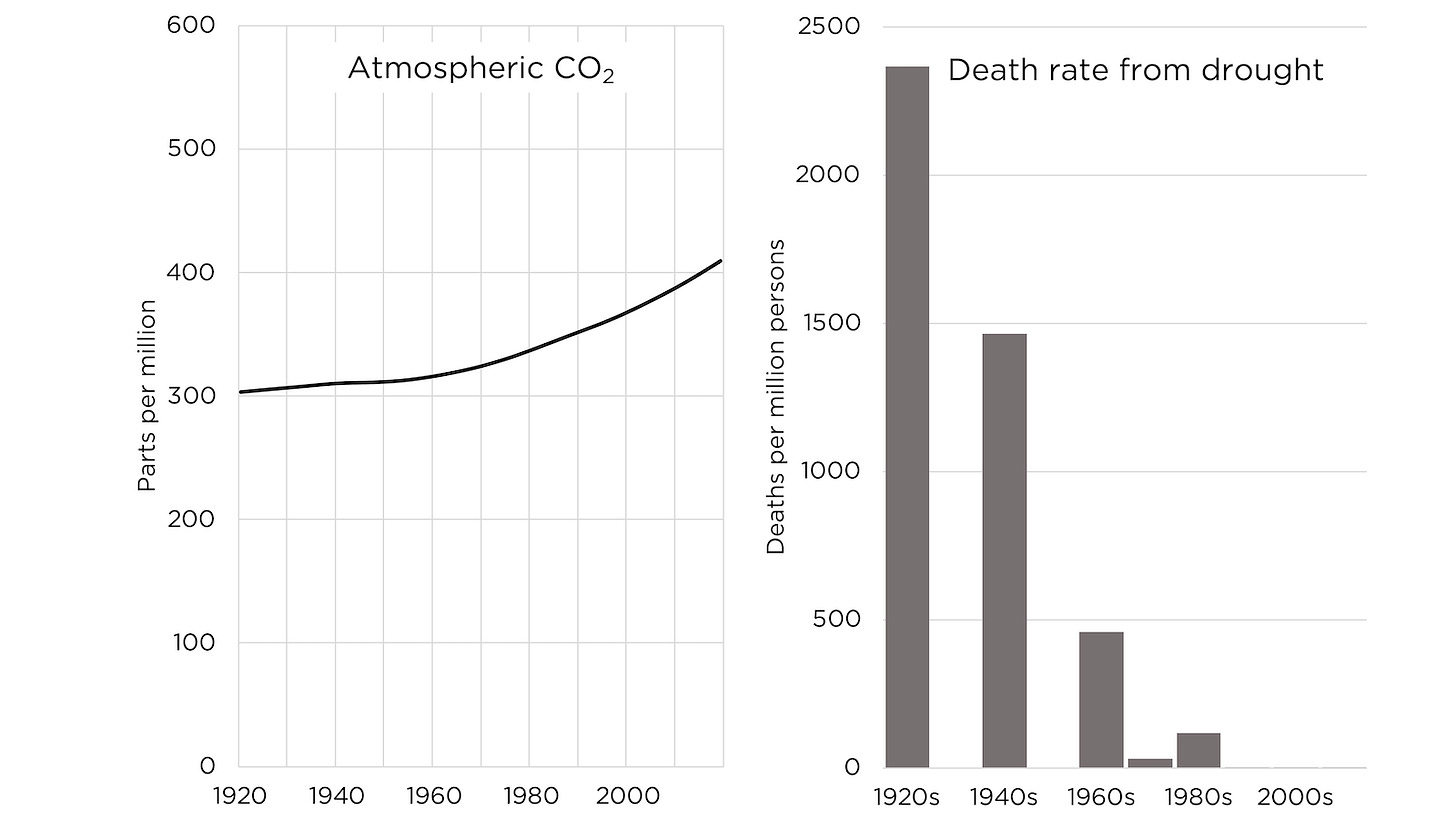
-
Myth 19: Floods are a bigger danger than ever thanks to fossil fuels.
Truth: Floods are a smaller danger than ever thanks to fossil-fueled flood control infrastructure and disaster relief.19
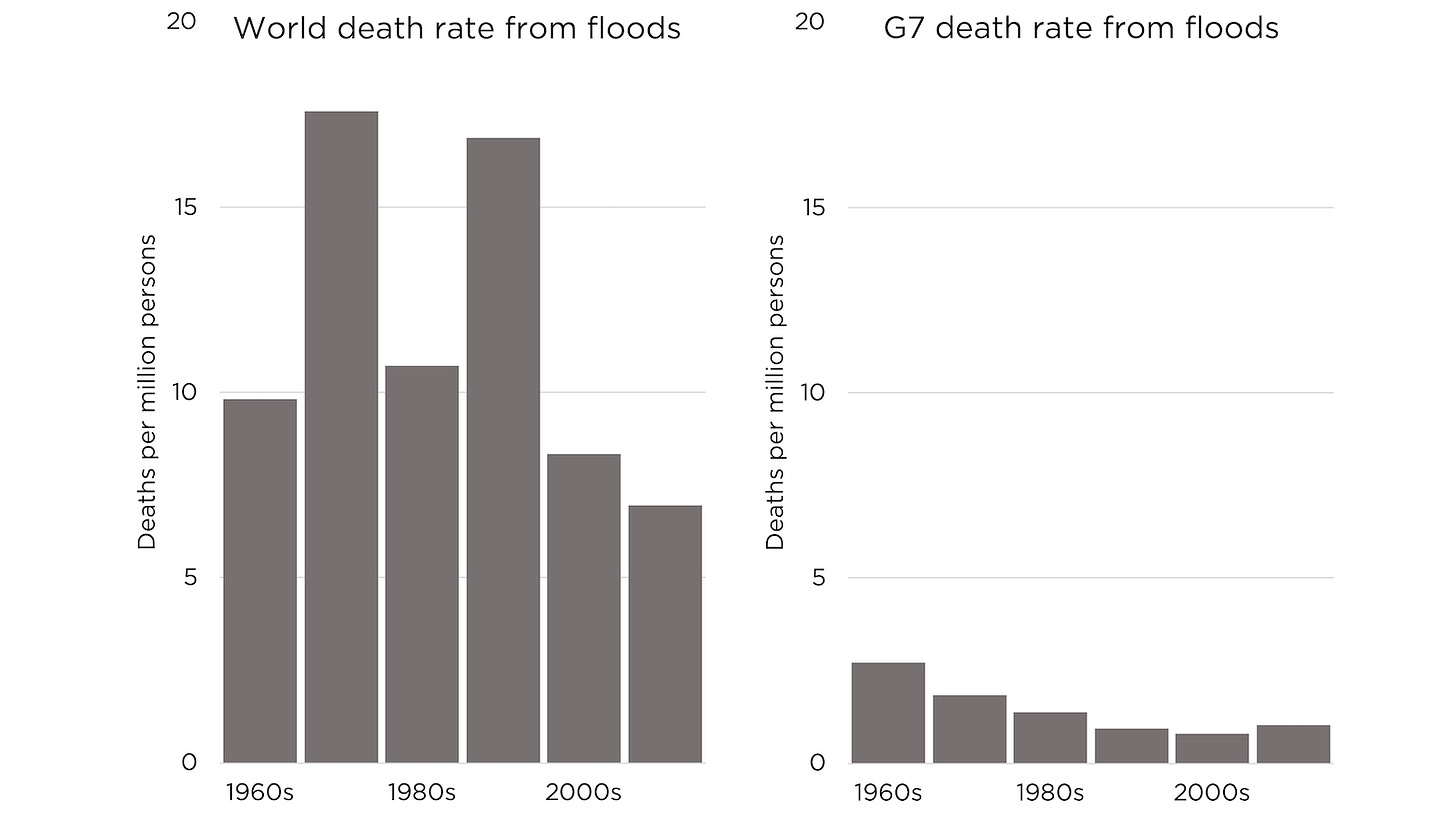
-
Myth 20: The rich, fossil-fueled world has ruined the poor world by making them vulnerable to extreme weather.
Truth: Fossil fuels have made everyone more prosperous and less vulnerable to extreme weather.
To be even better off the poor world needs more fossil fuels!20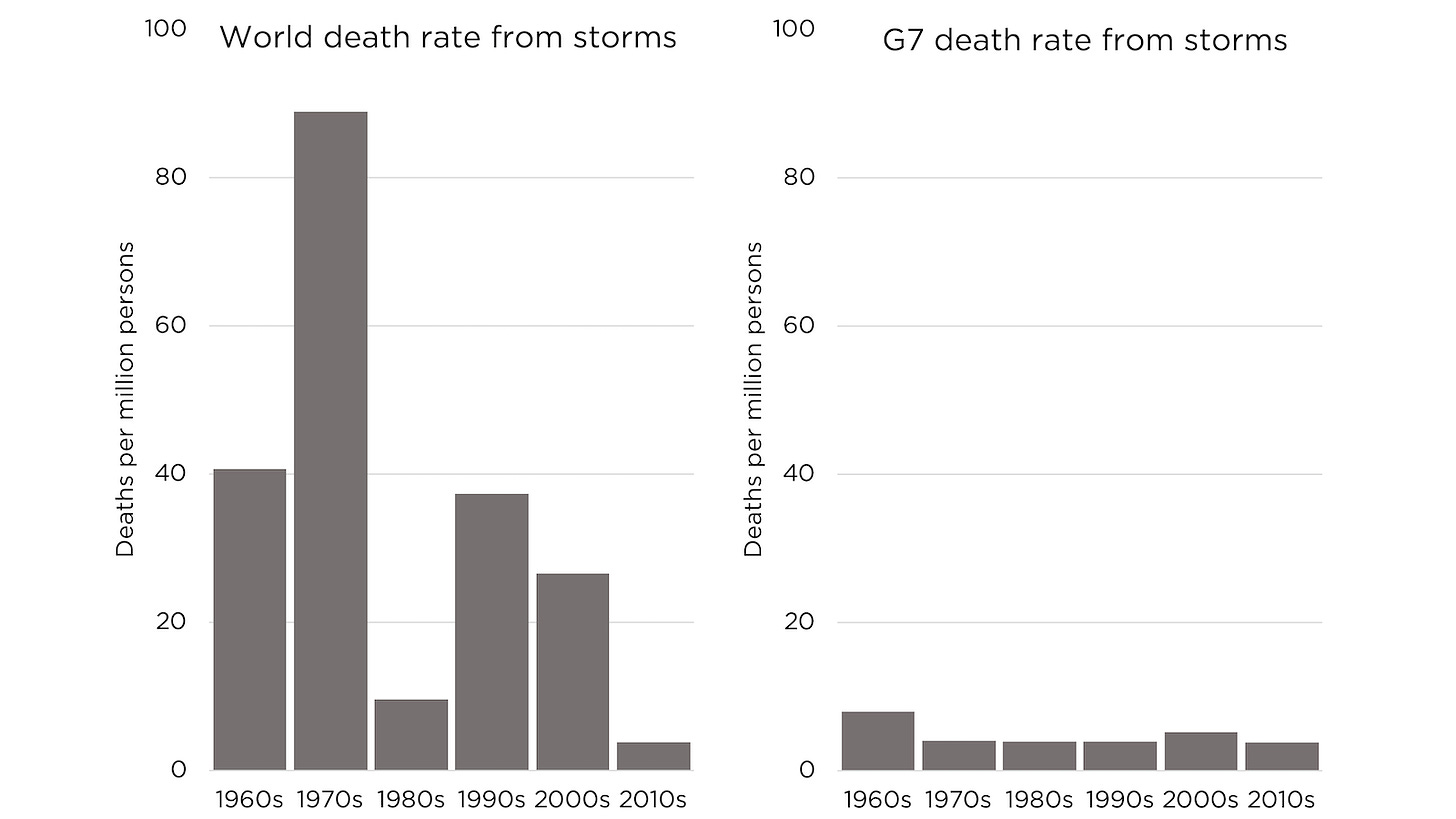
-
Myth 21: We can expect fossil fuels to make extreme weather far more dangerous in the future.
Truth: Fossil fuels’ climate mastery benefits have far overwhelmed any negative side-effects on extreme weather for 100+ years and there’s every reason to expect this to continue.21
-
Myth 22: Rapidly eliminating fossil fuels will make us safer from climate disasters.
Truth: Fossil fuels provide uniquely cost-effective energy in a world that needs far more energy. Rapidly eliminating fossil fuels means far less energy, which means catastrophic climate impotence—and mass death.22
-
Myth 23: Fossil fuel use made Idalia far more damaging.
Truth: Idalia would be far more dangerous without fossil fuel use.
Further, the role of rising CO2 levels in any given storm is highly speculative, leading scientists predict only modestly more powerful (and less frequent) storms.
-
Commentators try to claim a scientific connection between hurricanes and climate change because these storms are so impactful and could help their political agenda. But hurricanes are a particularly bad example because empirical science doesn't show a danger increase so far.23
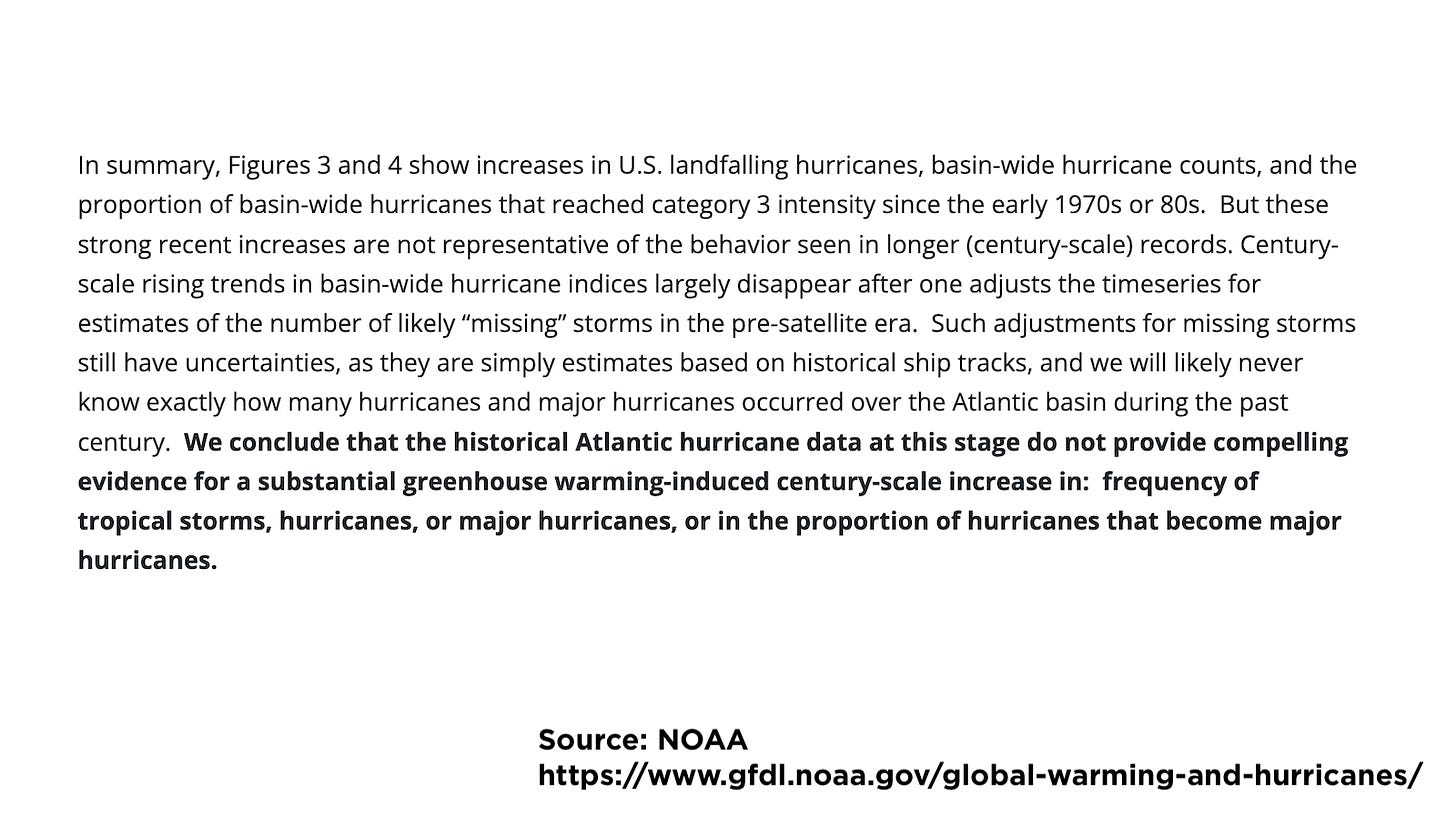
-
While leading scientists say that future hurricanes can become slightly stronger and less frequent, there is little evidence today of strong influence from warming so far. In any case, what we face is a level of danger that we can readily master—if we can use fossil fuels.
-
Commentators treating speculation about hurricanes being more dangerous right now due to climate change as fact are dishonest. How destructive a hurricane is today is mostly a function of the path it takes and the area's preparedness. Gladly, Florida seems to have avoided deaths.
-
Myth 24: When a major storm hits, politicians like Governor Ron DeSantis should commit to anti-fossil-fuel policies.
Truth: That would be pseudoscientific symbolism, and would make their constituents poorer and more vulnerable going forward. Like Europe, which is now afraid of winter.
-
It is absolutely shameful that the political opponents of Governor DeSantis are trying to blame him for the damage of Hurricane Idalia given that 1) the pro-freedom, pro-energy policies he supports lessened the damage and 2) his focus now is where it should be: hastening recovery.24
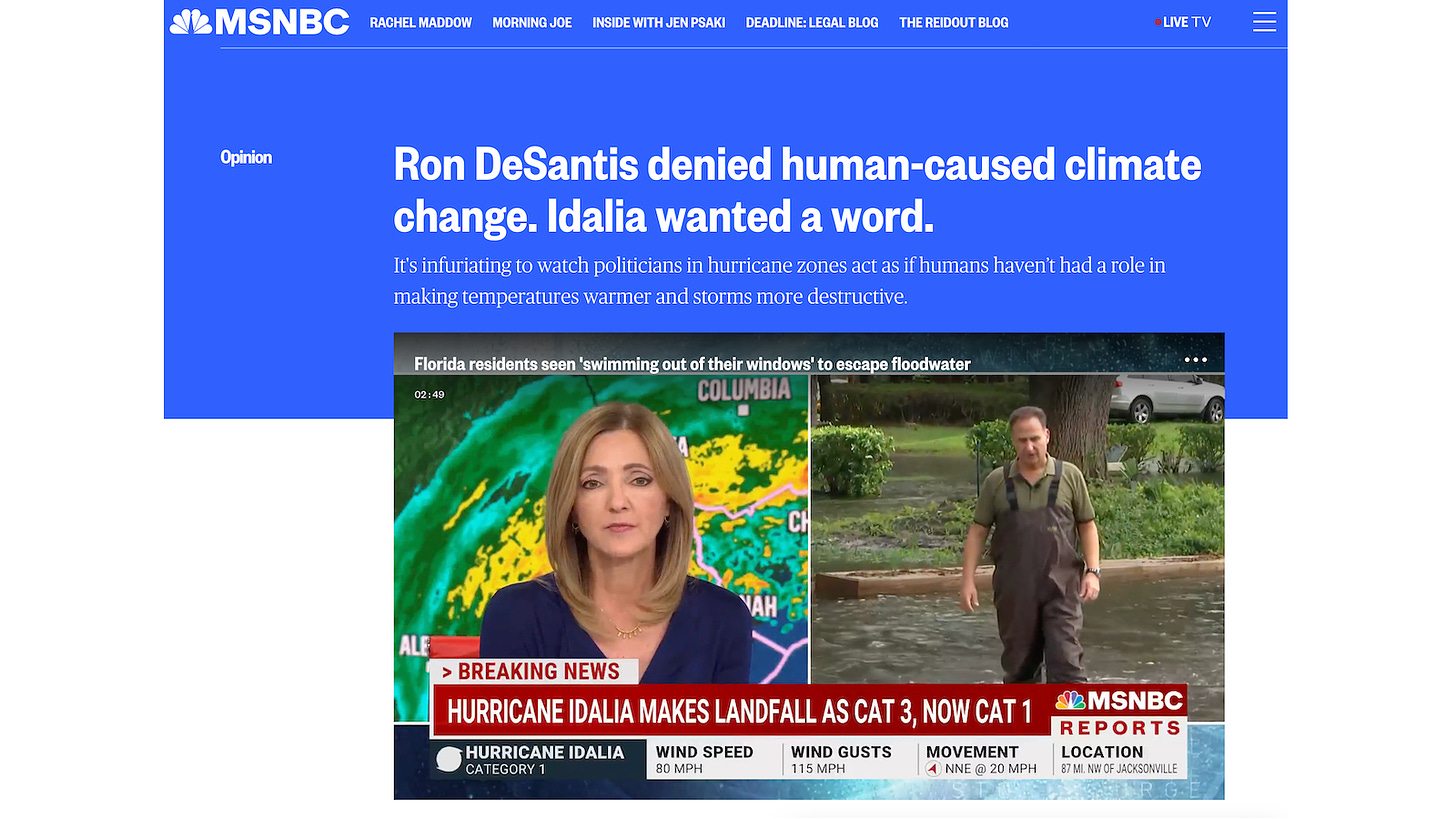
-
Myth 25: The next extreme weather event you hear about would have been much better if we had rapidly eliminated fossil fuels.
Truth: We will be far safer from that event thanks to fossil fuels. And we are also alive with our current life expectancy thanks to fossil fuels.
References
-
Reuters - Biden says climate crisis is undeniable after Hurricane Idalia damage↩
-
For every million people on earth, annual deaths from climate-related causes (extreme temperature, drought, flood, storms, wildfires) declined 98%--from an average of 247 per year during the 1920s to 2.5 per year during the 2010s.
Data on disaster deaths come from EM-DAT, CRED / UCLouvain, Brussels, Belgium – www.emdat.be (D. Guha-Sapir).
Population estimates for the 1920s from the Maddison Database 2010 come from the Groningen Growth and Development Centre, Faculty of Economics and Business at the University of Groningen. For years not shown, the population is assumed to have grown at a steady rate.
Population estimates for the 2010s come from World Bank Data.↩
-
For every million people on earth, annual deaths from climate-related causes (extreme temperature, drought, flood, storms, wildfires) declined 98%--from an average of 247 per year during the 1920s to 2.5 per year during the 2010s.
Data on disaster deaths come from EM-DAT, CRED / UCLouvain, Brussels, Belgium – www.emdat.be (D. Guha-Sapir).
Population estimates for the 1920s from the Maddison Database 2010 come from the Groningen Growth and Development Centre, Faculty of Economics and Business at the University of Groningen. For years not shown, the population is assumed to have grown at a steady rate.
Population estimates for the 2010s come from World Bank Data.↩
-
Alex Epstein - Talking Points on Earth Day truth: Fossil fuels make Earth BETTER↩
-
New York Time - Ian Moves North
Vecchi et al. (2021) - Changes in Atlantic major hurricane frequency since the late-19th century↩
-
Klotzbach et al. (2022) - Trends in Global Tropical Cyclone Activity: 1990–2021↩
-
Klotzbach et al. (2018) - Continental U.S. Hurricane Landfall Frequency and Associated Damage: Observations and Future Risks↩
-
Politico - The climatologist who put climate science ‘on the offensive’↩
-
Climate Etc. - New Confirmation that Climate Models Overstate Atmospheric Warming
Ross McKitrick - On the choice of TLS versus OLS in climate signal detection regression
Dr. Roy Spencer - Hot Summer Epic Fail: New Climate Models Exaggerate Midwest Warming by 6X↩
-
For every million people on earth, annual deaths from climate-related causes (extreme temperature, drought, flood, storms, wildfires) declined 98%--from an average of 247 per year during the 1920s to 2.5 per year during the 2010s.
Data on disaster deaths come from EM-DAT, CRED / UCLouvain, Brussels, Belgium – www.emdat.be (D. Guha-Sapir).
Population estimates for the 1920s from the Maddison Database 2010 come from the Groningen Growth and Development Centre, Faculty of Economics and Business at the University of Groningen. For years not shown, the population is assumed to have grown at a steady rate.
Population estimates for the 2010s come from World Bank Data.↩
-
Roger Pielke Jr. - Weather and Climate Disaster Losses So Far in 2022, Still Not Getting Worse
Roger Pielke Jr. - Tracking progress on the economic costs of disasters under the indicators of the sustainable development goals↩
-
Bjorn Lomborg - Climate Change Saves More Lives Than You’d Think↩
-
UC San Diego - The Keeling Curve
Data on disaster deaths come from EM-DAT, CRED / UCLouvain, Brussels, Belgium – www.emdat.be (D. Guha-Sapir).↩
-
UC San Diego - The Keeling Curve
Data on disaster deaths come from EM-DAT, CRED / UCLouvain, Brussels, Belgium – www.emdat.be (D. Guha-Sapir).↩
-
UC San Diego - The Keeling Curve
Data on disaster deaths come from EM-DAT, CRED / UCLouvain, Brussels, Belgium – www.emdat.be (D. Guha-Sapir).
Population estimates come from World Bank Data.↩
-
UC San Diego - The Keeling Curve
Data on disaster deaths come from EM-DAT, CRED / UCLouvain, Brussels, Belgium – www.emdat.be (D. Guha-Sapir).
Population estimates come from World Bank Data.↩
-
For every million people on earth, annual deaths from climate-related causes (extreme temperature, drought, flood, storms, wildfires) declined 98%--from an average of 247 per year during the 1920s to 2.5 per year during the 2010s.
Data on disaster deaths come from EM-DAT, CRED / UCLouvain, Brussels, Belgium – www.emdat.be (D. Guha-Sapir).
Population estimates for the 1920s from the Maddison Database 2010 come from the Groningen Growth and Development Centre, Faculty of Economics and Business at the University of Groningen. For years not shown, the population is assumed to have grown at a steady rate.
Population estimates for the 2010s come from World Bank Data.↩
-
MSNBC - Ron DeSantis denied human-caused climate change. Idalia wanted a word.↩
